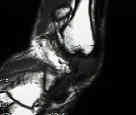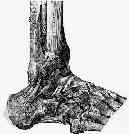Discussion
pathoanatomy:
- fibular collateral ligament is made up of three separate structures;
- these are not as strong as medial ligaments, since lateral support of ankle is also provide by the fibula;
- anterior talofibular ligament
- calcaneofibular ligament
- posterior talofibular Ligaments
- cervical ligaments:
- deltoid ligament resists abduction & lateral rotation of foot;
- sudden and forceful eversion, inverson, or rotation of the foot may tear the ligament stressed, or by acting through the ligament, may avulse the attached malleolus;
- in the vast majority of cases there will be a tear thru the ligament mid-substance;
- associated talar compression of opposite malleolus may cause frx;
- anterior talofibular ligament:
- w/ inversion force of foot, there is injury to anterolateral capsule, ATFL, & anterior tibiofibular ligament;
- about 40% of patients will have this injury type;
- calcaneofibular: as force progresses, this ligament is injured as well;
- in about 58% of cases, there will be a tear of both the ATFL and the CF ligament;
- finally in a small number of cases (3%) there will be tears of the above two ligament and the posterior talofibular ligaments;
differential diagnosis: ankle sprains:
- anterior impingement snydrome of the ankle
- calcaneocuboid joint injuries;
- type of inversion sprain that involves a portion of ligaments overlying the calcaneocuboid joint;
- causes immediate severe disability with pain, swelling, and tenderness that is localized to the region of the joint;
- frx of anterior process of calcaneus
- frx of the lateral talar processes
- frx of the posterior process
- syndesmotic sprain (high ankle sprain)
- midtarsal frx
- subtalar joint sprain
- osteochondral lesions of talus
- peroneal tendon disruption
- tarsal coaliltion
Physical Exam
- be sure to look for concomitant syndesmotic and subtalar instability;
- note any dysesthesia from the peroneal nerves, and point this out to the patient;
Radiographic Studies for Ankle Sprains
Non Operative Treatment
- non operative treatment is indicated for the majority of severe ankle sprains, and most patients w/ significant sprains will be back to work with in 10 days;
- prognosis (from Gerber, et al (1998))
- factor most predictive of delayed recovery and residual symptoms is concomitant syndesmotic sprain;
- most patients will be back to playing sports at 6 weeks, but about 1/2 will continue to significant symptoms even at 6 months;
- prognosis of tibiotalar tilt:
- despite the fact that most severe ankle sprains will initially demonstrate 15-18 deg of tibio-talar tilt (and in some cases will be as large as 40 deg), in most cases the ankle will stabilize down to 6 deg with conservative treatment;
- in patients w/ less than 15 deg of initial tibiotalar tilt, approximately 13% will have a poor result;
- in patients w/ more than 15 deg of initial tibiotalar tilt, approximately 22% will have a poor result;
- references:
- Management and rehabilitation of ligamentous injuries to the ankle.
- Radiological and muscular status following injury to the lateral ligaments of the ankle. Follow-up of 144 patients treated conservatively.
- Clinical and social status following injury to the lateral ligaments of the ankle. Follow-up of 144 patients treated conservatively.
- Persistent disability associated with ankle sprains: A prospective examination of an athletic population.
- Functional properties of adhesive ankle taping: Neuromuscular and mechanical effects before and after exercise.
- Spraining the Ankle Without Straining Credulity
- I Thought Everyone Knew That RICE Is Effective in Treating Acute Ankle Sprains!
Operative Management
- indications:
- in the meta-analysis report by Pijnenburg, et al, the authors concluded that a no-treatment strategy for ruptures of the lateral ankle ligaments leads to more residual symptoms.
- operative treatment leads to better results than functional treatment, and functional treatment leads to better results than cast immobilization for six weeks;
- reference:
- in the meta-analysis report by Pijnenburg, et al, the authors concluded that a no-treatment strategy for ruptures of the lateral ankle ligaments leads to more residual symptoms.
- prior to considerations for surgery, ensure that subtalar instability is not present;
- Modified Brostrom Procedure:
- generally operative treatment is considered when there is a persistant tibiotalar tilt greater than 20 deg;
- EDB transfer for chronic lateral ankle instability:
- EDB is detached proximally from the calcaneus and is sutured to the periosteum of the fibula;
- procedure helps to restore proprioception to the ankle;
- associated injuries which may require treatment:
- in report by DiGiovanni, et al (2000), the authors sought to determine injuries associated with lateral instability at the time of surgery;
- 61 patients underwent a primary ankle lateral ligament reconstruction for chronic instability between 1989 and 1996;
- in addition to the ligament reconstruction, all patients had evaluation of the peroneal retinaculum, peroneal tendon inspection by routine opening of the tendon sheath, and ankle joint inspection by arthrotomy;
- at surgery no patients were found to have isolated lateral ligament injury;
- injuries found most often by direct inspection included:
- peroneal tenosynovitis, 47/61 patients (77%);
- anterolateral impingement lesion, 41/61 (67%);
- attenuated peroneal retinaculum, 33/61 (54%);
- ankle synovitis, 30/61 (49%);
- intra-articular loose body, 16/61 (26%); peroneus brevis tear, 15/61 (25%);
- talus osteochondral lesion, 14/61 (23%); medial ankle tendon tenosynovitis, 3/61 (5%);
- Associated injuries found in chronic lateral ankle instability.
- peroneal tendon disruption
- peroneus brevis tear:
- longitudinal tears of the peroneus brevis are associated w/ ankle sprains;
- look for tendon tear at the level of the distal fibula;
- persistent swelling along the peroneal tendon sheath is a reliable sign for peroneus brevis tendon tear;
- this injury tends to occur from peroneal tendon subluxation over the posterolateral edge of the fibula;
- inciting cause is incompetence of the superior peroneal retinaculum;
- this allows subluxation of the peroneal tendons and mechanical attrition of the peroneus brevis tendon against the posterior ridge of the fibula;
- treatment: needs to address the tear and the peroneal subluxation;
- w/ damage of less than 50% tendon substance, consider tendon debridment;
- w/ damage of more than 50% of the tendon cross sectional area, consider excision of the damaged segment and tenodesis to the peroneus longus;
- valgus osteotomy:
- Idiopathic cavovarus and lateral ankle instability: Recognition and treatment implications relating to ankle arthritis.


- in report by DiGiovanni, et al (2000), the authors sought to determine injuries associated with lateral instability at the time of surgery;
- references
- Ruptures of the fibular collateral ligaments of the ankle. Result study of immediate surgical treatment.
- Static or dynamic repair of chronic lateral ankle instability. A prospective randomized study.
- Reconstruction of the lateral ligaments of the ankle for chronic lateral instability.
- Reconstruction of the lateral ligaments of the ankle using the plantaris tendon.
- Long-term results of the Chrisman-Snook operation for reconstruction of the lateral ligaments of the ankle.
- Lateral ligament reconstruction of the ankle with a modified Watson-Jones operation.
- Results of Watson-Jones ankle reconstruction for instability. The influence of articular damage.
- A new operation for chronic lateral ankle instability.
- Secondary reconstruction of the lateral ligaments of the ankle.
- Long-term results of the Evans procedure for lateral instability of the ankle.
- The effect of musculus extensor digitorum brevis transfer for chronic lateral ankle instability.
- Associated injuries found in chronic lateral ankle instability.
References
- Treatment for acute tears of the lateral ligaments of the ankle. Operation, cast, or early controlled mobilization.
- The contribution of the anterior talofibular ligament to ankle laxity.
- Talar shift. The stabilizing role of the medial, lateral, and posterior ankle structures.
- The deltoid ligament. An evaluation of need for surgical repair.
- Injury to the lateral ligaments of the ankle.
- The influence of dorsiflexion in the treatment of severe ankle sprains: an anatomical study.
- Instability of the ankle after injury to the lateral ligament.
- Early and late repair of lateral ligament of the ankle.
- Year Book: A Prospective Study of the Treatment of Severe Tears of the Lateral Ligament of the Ankle.
- Stability of the loaded ankle: Relation betweeen articular restraint and primary and secondary static restraints.
- Treatment of Ruptures of the Lateral Ankle Ligaments: A Meta-Analysis.
- Long-term results after modified Brostrom procedure without calcaneofibular ligament reconstruction
- Chronic Symptomatic Os Subfibulare in Children


